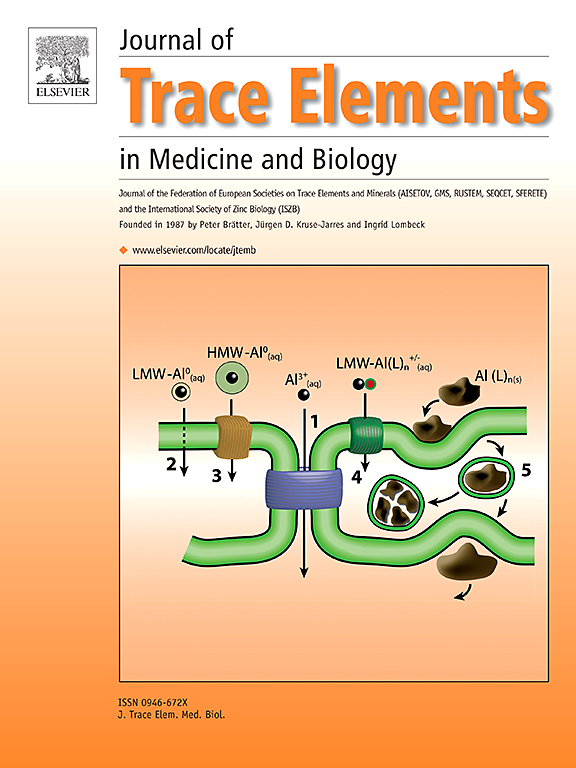不同聚乙二醇浓度对铁酸钴纳米颗粒抗癌作用及毒性评价的优化
IF 3.6
3区 医学
Q2 BIOCHEMISTRY & MOLECULAR BIOLOGY
Journal of Trace Elements in Medicine and Biology
Pub Date : 2025-07-17
DOI:10.1016/j.jtemb.2025.127698
引用次数: 0
摘要
聚乙二醇(PEG)作为包衣剂可以延长纳米颗粒(NPs)的循环时间,并保护无机核心免受细胞介导的即时免疫反应。钴铁氧体(CoFe2O4)由于其磁性而显示出良好的潜力,也被广泛用于刺激靶向反应性药物沉积机制来治疗局部癌细胞。方法在本研究中,通过不同浓度的PEG包覆CoFe2O4 NPs来优化NPs的抗癌潜力。经x射线衍射(XRD)分析,合成的CoFe2O4纳米粒子的晶粒尺寸为15.7 nm。采用傅里叶变换红外光谱(FTIR)和动态光散射(DLS)分析验证了涂层的浓度。不同PEG浓度下,CoFe2O4 NPs的表面电荷从−16.04 ~ 43.88 mV增加。用不同PEG(0.1, 0.125和0.25 g)功能化的CoFe2O4 NPs对人胚胎肾癌(HEK293T)细胞系获得最佳的抗癌作用。结果裸CoFe2O4 NPs的IC50值为76.943 μg/mL, PEG0.25包被CoFe2O4 NPs的IC50值为35.762 μg/mL。这表明聚合物包覆的CoFe2O4 NPs的抗癌性能有了显著提高。为了确保CoFe₂O₄NPs的安全应用,我们对白化大鼠进行了体内毒性研究。结果显示肝毒性和肾毒性呈剂量依赖性,肝酶(AST >;200 U/L和ALT >;60 U/L)和血尿素氮升高(BUN≥70 mg/dL),表明较高剂量可能造成器官损伤。这些发现强调,在使用CoFe₂O₄NPs进行癌症治疗时,需要仔细考虑治疗效果和安全性。本文章由计算机程序翻译,如有差异,请以英文原文为准。

Optimizing the anticancer action and toxicity evaluation of cobalt ferrite nanoparticles by different polyethylene glycol concentrations
Background
Polyethylene glycol (PEG) as a coating agent enhances the circulation time of nanoparticles (NPs) and shields the inorganic core from the immediate cell-mediated immune response. Cobalt ferrite (CoFe2O4) has shown promising potential due to its magnetic properties and is also widely used to stimulate targeted responsive drug deposition mechanisms to treat localized cancerous cells.
Methodology
In this study, the anticancer potential of CoFe2O4 NPs was optimized by coating the NPs with different PEG concentrations. The synthesized CoFe2O4 NPs have a crystallite size of 15.7 nm, determined by X-ray diffraction (XRD) analysis. Coating concentrations were verified by Fourier Transform Infrared (FTIR) spectroscopy and Dynamic Light Scattering (DLS) analysis. The surface charge of the CoFe2O4 NPs increased from −16.04–43.88 mV for different PEG concentrations. The CoFe2O4 NPs functionalized with varying PEG concentrations, i.e., 0.1, 0.125, and 0.25 g, were used to obtain the optimum anticancer action against the human embryonic kidney cancerous (HEK293T) cell line.
Results
The IC50 value for bare CoFe2O4 NPs was 76.943 μg/mL, however, the optimum response was received when CoFe2O4 NPs were coated with PEG0.25 with an IC50 value of 35.762 μg/mL. This indicates a significant improvement in the anticancer property of CoFe2O4 NPs with polymer coating. To ensure the safe application of CoFe₂O₄ NPs, in vivo toxicity studies were conducted in albino rats. Results indicated a dose-dependent hepatotoxicity and nephrotoxicity, with elevated levels of liver enzymes (AST > 200 U/L and ALT > 60 U/L) and increased blood urea nitrogen (BUN ≥ 70 mg/dL), signaling potential organ damage at higher doses. These findings emphasize the need for careful consideration of both the therapeutic efficacy and safety profile when using CoFe₂O₄ NPs for cancer treatment.
求助全文
通过发布文献求助,成功后即可免费获取论文全文。
去求助
来源期刊
CiteScore
6.60
自引率
2.90%
发文量
202
审稿时长
85 days
期刊介绍:
The journal provides the reader with a thorough description of theoretical and applied aspects of trace elements in medicine and biology and is devoted to the advancement of scientific knowledge about trace elements and trace element species. Trace elements play essential roles in the maintenance of physiological processes. During the last decades there has been a great deal of scientific investigation about the function and binding of trace elements. The Journal of Trace Elements in Medicine and Biology focuses on the description and dissemination of scientific results concerning the role of trace elements with respect to their mode of action in health and disease and nutritional importance. Progress in the knowledge of the biological role of trace elements depends, however, on advances in trace elements chemistry. Thus the Journal of Trace Elements in Medicine and Biology will include only those papers that base their results on proven analytical methods.
Also, we only publish those articles in which the quality assurance regarding the execution of experiments and achievement of results is guaranteed.

 求助内容:
求助内容: 应助结果提醒方式:
应助结果提醒方式:


